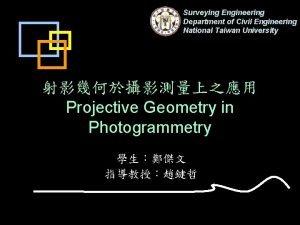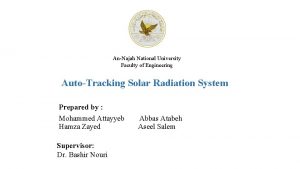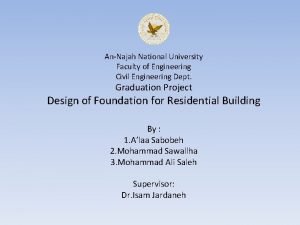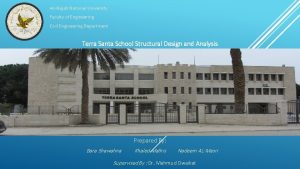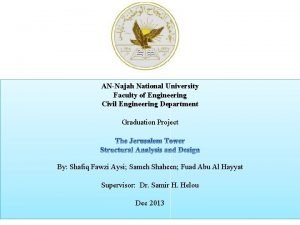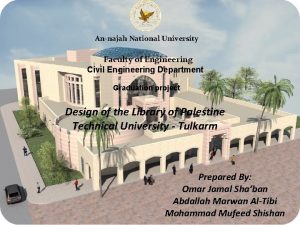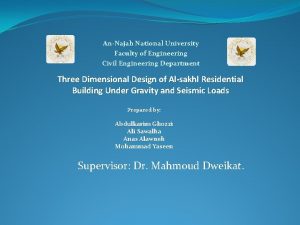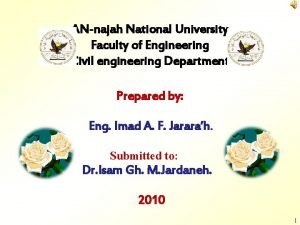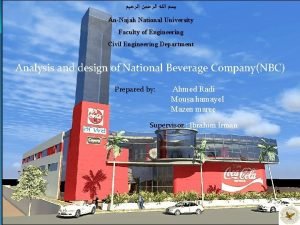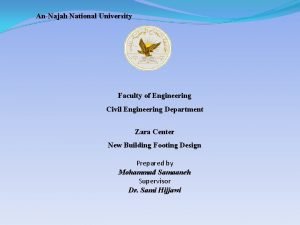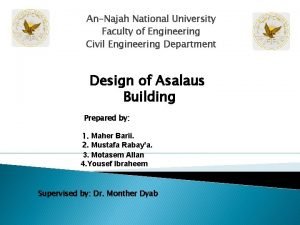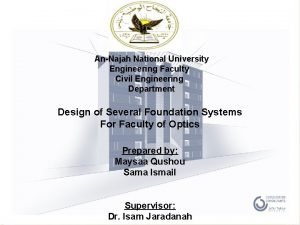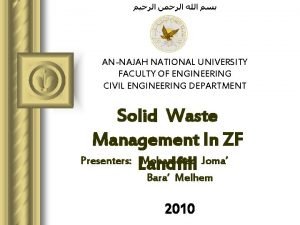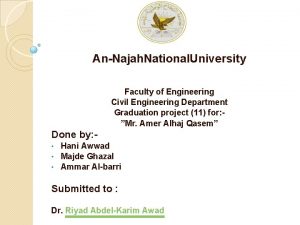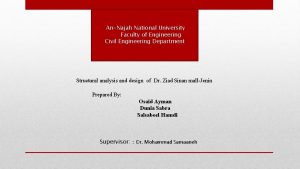Annajah National University Faculty of Engineering Civil Engineering














































- Slides: 46

An-najah National University Faculty of Engineering Civil Engineering Department Graduation project Design of the Library of Palestine Technical University - Tulkarm Prepared By: Omar Jamal Sha’ban Abdallah Marwan Al-Tibi Mohammad Mufeed Shishan

Chapters o Chapter One : Introduction o Chapter Two : Preliminary Design o Chapter Three : Three Dimensional Structural Analysis and Design

CHAPTER ONE : INTRODUCTION General This is a graduation project that introduces analysis and design of reinforced concrete structure. This structure is the building for the library of Palestine Technical University (PTU) in Tulkarem city – Palestine. The building will be analyzed and designed using the primary principles of structural analysis and design by using one dimensional structural analysis and also using the most modern analysis of structures which is the three dimensional structural analysis and design.

Figure 1. 1: Architectural 3 D model of the building Note: The red lines in the previous figure are related to expansion joints

The building is divided into three parts which are separated by expansion joints. Figure 1. 1 shows a three dimensional image of the building. Part A in the building is composed of four stories and is used as a library. The first story is an underground (basement) story whose area is about 743. 0 m 2 and its height is 3. 90 m. The other three stories is an over ground stories, and the area of each one is about 1546 m 2 and its height is 4. 42 m. There is a steel dome in the last story at the roof. Part B is used as offices, video conference and arcade. And it is composed of an over ground story whose area is about 472. 0 m 2 and its height is 4. 42 m. Part C has not been designed.

Codes and Standards The structures are designed using practice code and specifications that control the design process and variables. The following codes and standards are used in this study: ü ACI 318 -08 : American Concrete Institute provisions for reinforced concrete structural design. ü UBC-97 : Uniform Building Code provisions for seismic load parameters determination. ü IBC-2009 : International Building Code, which is used here for live loads. ü ASTM : For material specifications.

Loads and Load combinations Loads 1) Gravity loads: Live load: It comes from the people, machines and any movable objects in the buildings. The amount of live load depends on the type of the structure. In this project the live load is: 7. 0 k. N/m 2 (for Part A) 3. 0 k. N/m 2 (for Part B) Dead load: it is consisting of own weight of the structure and any permanent components. The super imposed dead load is 3. 5 k. N/m 2.

2) Lateral loads: Seismic loads: The structure is located in Tulkarm area which is classified as zone 2 A according to Palestine seismic zones. The UBC 97 code seismic parameters are as follows: The seismic zone factor, Z= 0. 15. The soil is very dense soil and soft rock, so the soil type is Sc. The importance factor, I = 1. 0. The ductility factor, R = 5. 5. The seismic coefficient, Ca = 0. 18. The seismic coefficient, Cv = 0. 25.

Load combinations The ACI 318 -08 load combinations are used and they are summarized as follows: U 1 = 1. 4 D U 2 = 1. 2 D + 1. 6 L + 1. 6 H U 3 = 1. 2 D + 1. 0 E + 1. 0 L U 4 = 0. 9 D + 1. 0 E + 1. 6 H Where: D : is dead load L : is live load H : is weight and pressure load of soil E : is earthquake load

Materials Structural materials Concrete: Concrete strength for all concrete parts is B 350 ( f’c = 280 Kgcm 2 , 28 MPa ) Modulus of elasticity equals 2. 5*105 Kgcm 2 , 2. 5*104 MPa Unit weight is 25 k. Nm 3 Steel: Modulus of elasticity equals 2. 04*10 6 Kgcm 2 , 2. 04*105 MPa For steel reinforcement, is 4200 Kgcm 2 , 420 MPa Non-structural materials They are mainly, blocks, plasters, tiles, filling, mortar and masonry.

Building Structural Systems The structural system in the building parts ( A and B) shall be as follows: In part A, the four floors are designed as ribbed slab with main hidden beams carried by columns. In part B, the floor is designed as one way ribbed slab in X and in Y direction with hidden beams. Basement walls are used around the ground floor, and all the exterior walls are composed of concrete, masonry and blocks. The masonry stones are fixed to the reinforced concrete walls using concrete mortar.

CHAPTER TWO : PRELIMINARY DESIGN Design of Slabs Ribbed slab analysis and design (Part A) The thickness of the slab: hmin = Ln/33 = 890 -50/33 = 25. 45 cm Use h=30 cm (since the loads are heavy). Where Ln : The maximum spacing between the columns.

The direct design method will be used to check the preliminary dimensions of the slab and beams. So, one frame will be taken in calculations to represent the whole slabs as approximation. The ribbed slab can be divided to frames in each direction. Here , calculations are made for Frame A shown in figure ( 2 -1) Frame bending moment also shown in figure (2 -2)

Figure 2. 1 Plan of the slab in the basement floor and frame A is hatched Figure 2. 2 Moments in Frame A

Figure 2. 3 Percentages and values of the moments on the strips of span # 2 For column strip: As for negative moment = 4Ø 20 2Ø 20 / layer For column strip: As for positive moment = 2Ø 16 For beam in the Frame D= 45 cm, B= 100 cm: As for negative moment = 6Ø 20 For beam in the Frame D= 45 cm, B= 100 cm: As for positive moment = 5Ø 20 For middle strip: As for negative moment = 2Ø 14 For middle strip: As for positive moment = 2Ø 14

Figure 2. 4 Percentages and values of the moments on the strips of span # 1 For column strip: As for negative moment = 4Ø 18 2Ø 18 / layer & 2Ø 14 For column strip: As for positive moment = 2Ø 20 For beam in the Frame: As for negative moment = 5Ø 20 & 5Ø 20 For beam in the Frame: As for positive moment = 5Ø 20 For middle strip: As for negative moment = 2Ø 14 For middle strip: As for positive moment = 2Ø 14

Ribbed slab analysis and design (Part B) The thickness of the slab: hmin = l/21 = 800/21 = 38 cm Use h=40 cm

Design of Rib 5 in part B Rib load Diagram (in k. N/m) Rib Bending Moment Diagram (in k. N. m)

Max. neg. moment= 16. 01 k. N. m/rib �� = 0. 00235 �� min = 0. 00333 As = 2Ø 12 Max. +ve moment= 13. 64 k. N. m/rib �� = 0. 000537 �� min = 0. 00333 As = 2Ø 12

Design of column # 15 The ultimate load on the column is found using tributary area and number of stories, and the design load can be calculated using the following equation: Tributary area=59. 085 m 2 Number of stories= 5 Wu=24 k. N/m 2 Pu=59. 08 x 5 x 24 = 7089. 6 k. N Pn req = 7089. 6 / 0. 65 = 10907. 0 k. N Assume �� = 0. 01 Pd= Ф Pn = Ф *λ {0. 85* fc(Ag-As) + As* fy} = 1090. 70 x 1000=0. 8 {0. 85 x 280 x(-) + 0. 01 x A gx 4200} Ag= 1090. 70*1000 / 222. 1 = 4910. 85 cm 2 Square column b=h =70. cm use (80 x 80) the area of column to account for additional moments and lateral forces

Chapter Three Dimensional Structural Analysis and Design

* General This chapter is a three dimensional analysis and design, which introduces the final and practical structural analysis and design of the structural elements with the practical structural drawings that are ready for construction. Structural analysis comprises of set of physical and mathematical laws required to study and predict the behaviour of structures under a given set of actions. The structural analysis of the model is aimed to determine the external reactions at the supports and the internal forces like bending moments, shear forces, and normal forces for the different members. Theses internal member forces are used to design the cross section of three elements.

Property/Stiffness Modification Factors Basic calculations

Two way slab system: Part A Membrane f 11 modifier = (A 1 / A 3)= 0. 1165/0. 301 = 0. 387 Membrane f 22 modifier = (A 1 / A 3)= 0. 1165/0. 301 = 0. 387 Membrane f 12 modifier = (A 1 / A 3)= 0. 1165/0. 301 = 0. 387 Bending m 11 modifier = 0. 25*( I 1 / I 3) = 0. 25*(2. 2108*10 -3/5. 087*10 -3) = 0. 108 Bending m 22 modifier = 0. 25*( I 1 / I 3) = 0. 25*(2. 2108*10 -3/5. 087*10 -3) = 0. 108 Bending m 12 modifier = (C ribbed / C solid) = (6. 2968*10 -4/11. 739*10 -3) = 0. 0536 Shear v 13 modifier = (A 1 / A 3)= 0. 1165/0. 301 = 0. 387 Shear v 23 modifier = (A 1 / A 3)= 0. 1165/0. 301 = 0. 387 Mass m modifier = (M two way rib / M solid) = (9. 08/11. 25) = 0. 80 Weight w modifier = (9. 81*M two way rib / 9. 81*M solid)= (9. 08/11. 25) = 0. 80

Part B One way slab system (y-direction): Membrane f 11 modifier = (A 2/A 3) = 0. 044/0. 22 = 0. 2 Membrane f 22 modifier = (A 1/A 3) = 0. 092/0. 22 = 0. 418 Membrane f 12 modifier = (A 2/A 3) = 0. 044/0. 22 = 0. 2 Bending m 11 modifier = 0. 25*( I 2/ I 3) = 0. 25*(2. 346710 -5 / 2. 93310 -3) = 0. 002 Bending m 22 modifier = 0. 25*( I 1/ I 3) = 0. 25*(2. 346710 -5 / 2. 93310 -3) = 0. 139 Bending m 12 modifier = 0. 25*( I 2/ I 3) = 0. 25*(2. 346710 -5 / 2. 93310 -3) = 0. 002 Shear v 13 modifier = (A 2/A 3) = 0. 044/0. 22 = 0. 2 Shear v 23 modifier = (A 1/A 3) = 0. 092/0. 22 = 0. 4 18 Mass m modifier = (M 1 way rib / M solid) = (0. 7/1)= 0. 7 Weight w modifier = (9. 81*M 1 way rib/ 9. 81*M solid) = (0. 7/1) = 0. 7

One way slab system (x-direction): Membrane f 11 modifier = (A 1/A 3) = 0. 092/0. 22 = 0. 418 Membrane f 22 modifier= (A 2/A 3) = 0. 044/0. 22 = 0. 2 Membrane f 12 modifier = (A 2/A 3) = 0. 044/0. 22 = 0. 2 Bending m 11 modifier = 0. 25*( I 1/ I 3) = 0. 25*(2. 346710 -5 / 2. 93310 -3) = 0. 139 Bending m 22 modifier = 0. 25*( I 2/ I 3) = 0. 25*(2. 346710 -5 / 2. 93310 -3) = 0. 002 Bending m 12 modifier = 0. 25*( I 2/ I 3) = 0. 25*(2. 346710 -5 / 2. 93310 -3) = 0. 002 Shear v 13 modifier = (A 1/A 3) = 0. 092/0. 22 = 0. 418 Shear v 23 modifier = (A 2/A 3) = 0. 044/0. 22 = 0. 2 Mass m modifier = (M 1 way rib / M solid) = (0. 7/1) = 0. 7 Weight w modifier = (9. 81*M 1 way rib / 9. 81*M solid) = (0. 7/1)= 0. 7

Structural Model Verification of Part A Check Equilibrium The total building dead load = 77047. 1 k. N The total building live load = 33627. 72 k. N From SAP 2000: Total dead load = 74204. 27 k. N Total live load = 33109. 0 k. N Error % in dead load= 3. 68 %< 5% ok. Error % in live load = 1. 54 %< 5% ok.

Check Compatibility

Structural Model Verification of Part B Check Equilibrium The total building dead load = 7761. 8 k. N The total building live load = 1421. 16 k. N From SAP 2000: Total dead load = 7402. 87 k. N Total live load = 1394. 19 k. N Error % in dead load = 4. 6 %< 5% ok. Error % in live load = 1. 9 %< 5% ok.

Check Compatibility

Design of slabs of Part A Basement floor Rib 1 For negative moment use 2 Ф 22 For positive moment use 2 Ф 14 Rib 2 For negative moment use 2 Ф 20 For positive moment use 2 Ф 14

*Analysis and Design of Beams:

Design of columns

Analysis and Design of Footings footings which used in this project can be classified into the following types : 1) Isolated footing: they have rectangular, square, or circular shape. This type of footing is used for small loads, and/or large soil allowable bearing capacity. 2) Wall footing: it is a continuous footing along the length of the wall.

LEVEL ONE

LEVEL TWO


Design Of Shear Walls: For Part A: Shear wall (SW 1): Vertical reinforcement: Pu = 1531. 8 k. N, Mu = 666. 1 k. N ρmin = 0. 0012 , h = 11. 80 m , b = 0. 3 m. As min = 0. 0012 X 1180 X 30 = 42. 48 cm 2 As min for each face = 42. 48/2 = 21. 24 cm 2 From SAP 2000: Use 1 Ф 16 / 20 cm Horizontal reinforcement: ρmin = 0. 002 , h = 1 m , b = 0. 2 m. As min = 0. 002 X 100 X 20 = 4 cm 2 As min for each face = 4/2 = 2 cm 2 From SAP 2000: Use 1 Ф 18 / 25 cm As a result, for all shear walls: Vertical reinforcement: Use 1 Ф 16 / 20 cm. Horizontal reinforcement: Use 1 Ф 18 / 25 cm

Design of Stairs Dimensions: Thickness of landing= Ln /20 = 195/20 = 9. 75 cm. Thus 15 cm thickness is suitable. Thickness of flight= Ln /24 = 285/24 = 12 cm. Thus 15 cm thickness is suitable. Loads: SID Load= 3. 5 k. N/m 2 , LL=5 k. N/m 2 Design of flight: Mu = 17 k. N. m As = 3. 1 cm 2 / m use 1 Ф 14 / 20 cm Design of landing: Mu = 8 k. N. m As = 2. 7 cm 2 / m use 1 Ф 14 / 25 cm

Reinforcement Of Stairs

Thanks for listening



An-najah National University Faculty of Engineering Civil Engineering Department Graduation project Design of the Library of Palestine Technical University - Tulkarm Prepared By: Omar Jamal Sha’ban Abdallah Marwan Al-Tibi Mohammad Mufeed Shishan


 National taiwan university civil engineering
National taiwan university civil engineering Czech technical university in prague civil engineering
Czech technical university in prague civil engineering Civil engineering faculty
Civil engineering faculty Panti asuhan annajah
Panti asuhan annajah Logo annajah
Logo annajah Annajah motors
Annajah motors Annajah motors
Annajah motors Feup university of porto
Feup university of porto Lebanese university roumieh
Lebanese university roumieh Ece clemson
Ece clemson Faculty of mechanical engineering thammasat university
Faculty of mechanical engineering thammasat university Czech technical university in prague civil engineering
Czech technical university in prague civil engineering Civil rights webquest
Civil rights webquest Herszon kherson maritime college of merchant marine fleet
Herszon kherson maritime college of merchant marine fleet University of bridgeport computer science
University of bridgeport computer science University of bridgeport computer science faculty
University of bridgeport computer science faculty Hubert kairuki memorial university faculty of medicine
Hubert kairuki memorial university faculty of medicine Solid thyroid nodule
Solid thyroid nodule King abdulaziz university faculty of medicine
King abdulaziz university faculty of medicine Florida state computer science
Florida state computer science Mendel university - faculty of business and economics
Mendel university - faculty of business and economics Singularity university faculty
Singularity university faculty Territorial matrix vs interterritorial matrix
Territorial matrix vs interterritorial matrix Masaryk university medical faculty
Masaryk university medical faculty Ldap cuni
Ldap cuni Faculty of veterinary medicine cairo university logo
Faculty of veterinary medicine cairo university logo Faculty of law of the university of zagreb
Faculty of law of the university of zagreb University of montenegro faculty of law
University of montenegro faculty of law University of kragujevac faculty of technical sciences
University of kragujevac faculty of technical sciences University of cologne faculty of management
University of cologne faculty of management Leading university faculty
Leading university faculty Hacettepe university faculty of medicine
Hacettepe university faculty of medicine Brown university computer science faculty
Brown university computer science faculty Conus arteriosus
Conus arteriosus Semmelweis university faculty of medicine
Semmelweis university faculty of medicine Yorku myfile
Yorku myfile University of debrecen faculty of economics and business
University of debrecen faculty of economics and business Faculty of veterinary medicine cairo university
Faculty of veterinary medicine cairo university Mendel university faculty of business and economics
Mendel university faculty of business and economics Masaryk university medical faculty
Masaryk university medical faculty Slidetodoc.com
Slidetodoc.com Thin and thick smear
Thin and thick smear Faculty of education khon kaen university
Faculty of education khon kaen university Chulalongkorn university uniform
Chulalongkorn university uniform Cairo university faculty of veterinary medicine
Cairo university faculty of veterinary medicine Lee kong chian faculty of engineering and science
Lee kong chian faculty of engineering and science Benha faculty of engineering
Benha faculty of engineering
